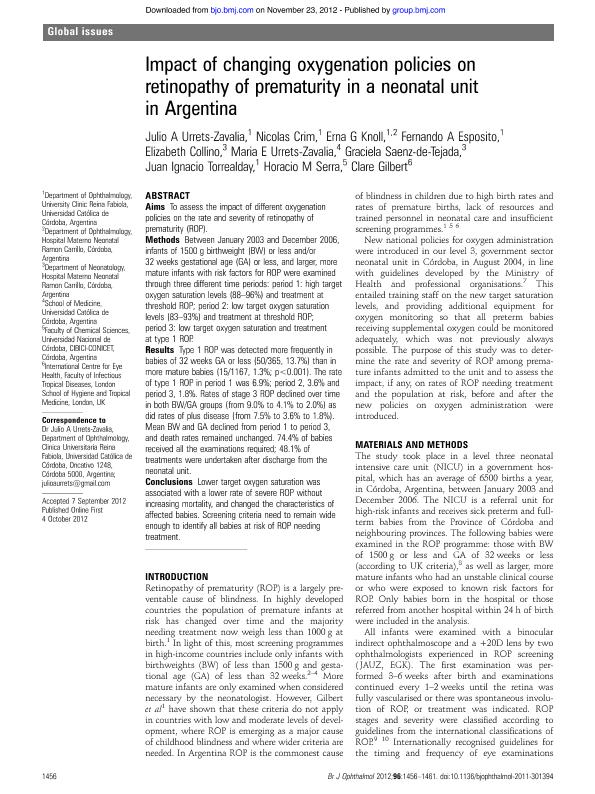Artículo
Impact of changing oxygenation policies on retinopathy of prematurity in a neonatal unit in Argentina
Urrets Zavalía, Julio Alberto; Crim, Nicolás; Knoll, Erna G.; Espósito, Fernando Augusto; Collino, Elizabeth; Urrets Zavalía, Maria E.; Saenz de Tejada, Graciela; Torrealday, Juan Ignacio; Serra, Horacio Marcelo ; Gilbert, Clare
; Gilbert, Clare
 ; Gilbert, Clare
; Gilbert, Clare
Fecha de publicación:
10/2013
Editorial:
B M J Publishing Group
Revista:
British Journal Of Ophthalmology
ISSN:
0007-1161
Idioma:
Inglés
Tipo de recurso:
Artículo publicado
Clasificación temática:
Resumen
Aims: To assess the impact of different oxygenation policies on the rate and severity of retinopathy of prematurity (ROP). Methods: Between January 2003 and December 2006, infants of 1500 g birthweight (BW) or less and/or 32 weeks gestational age (GA) or less, and larger, more mature infants with risk factors for ROP were examined through three different time periods: period 1: high target oxygen saturation levels (88–96%) and treatment at threshold ROP; period 2: low target oxygen saturation levels (83–93%) and treatment at threshold ROP; period 3: low target oxygen saturation and treatment at type 1 ROP. Results: Type 1 ROP was detected more frequently in babies of 32 weeks GA or less (50/365, 13.7%) than in more mature babies (15/1167, 1.3%; p<0.001). The rate of type 1 ROP in period 1 was 6.9%; period 2, 3.6% and period 3, 1.8%. Rates of stage 3 ROP declined over time in both BW/GA groups (from 9.0% to 4.1% to 2.0%) as did rates of plus disease (from 7.5% to 3.6% to 1.8%). Mean BW and GA declined from period 1 to period 3, and death rates remained unchanged. 74.4% of babies received all the examinations required; 48.1% of treatments were undertaken after discharge from the neonatal unit. Conclusions: Lower target oxygen saturation was associated with a lower rate of severe ROP without increasing mortality, and changed the characteristics of affected babies. Screening criteria need to remain wide enough to identify all babies at risk of ROP needing treatment.
Palabras clave:
Retinopathy
,
Oxygenation
,
Blindness
Archivos asociados
Licencia
Identificadores
Colecciones
Articulos(CIBICI)
Articulos de CENTRO DE INV.EN BIOQUI.CLINICA E INMUNOLOGIA
Articulos de CENTRO DE INV.EN BIOQUI.CLINICA E INMUNOLOGIA
Citación
Urrets Zavalía, Julio Alberto; Crim, Nicolás; Knoll, Erna G.; Espósito, Fernando Augusto; Collino, Elizabeth; et al.; Impact of changing oxygenation policies on retinopathy of prematurity in a neonatal unit in Argentina; B M J Publishing Group; British Journal Of Ophthalmology; 96; 12; 10-2013; 1456-1461
Compartir
Altmétricas



